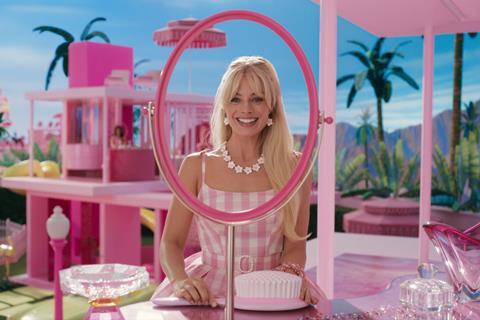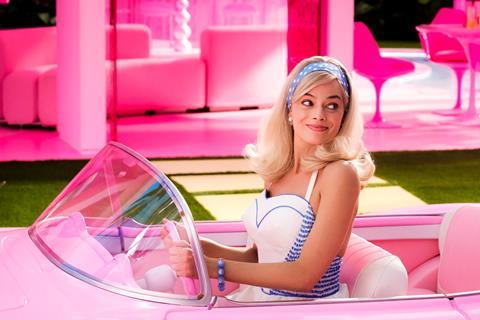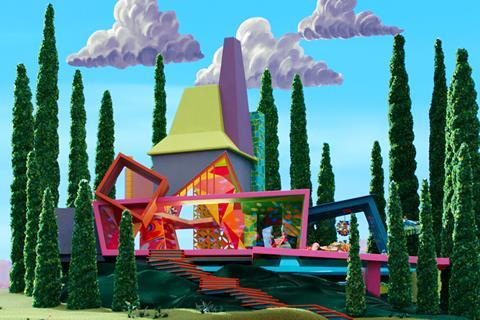A two-decade working relationship binds Barbie production designer Sarah Greenwood, set decorator Katie Spencer and costume designer Jacqueline Durran. They tell Screen how they tackled their most distinctive project to date.

“Why us?” It was an early question posed to Barbie director Greta Gerwig by Sarah Greenwood and Katie Spencer — production designer and set decorator, respectively — known for their period design with layered textures and moody patinas in films such as Atonement, Anna Karenina and Darkest Hour.
“She said, ‘Because you build worlds around characters,’” says Greenwood. “To her, it was like, ‘Why are you even asking that question?’ But once she said it, we understood. Though it was difficult, to be truthful, doing something in that palette and with that minimalism — even though it doesn’t look minimal, it was; you’re taking things away all the time, refining things.”
For the Warner Bros-backed Barbie, costume designer Jacqueline Durran rounded out a design trio that has collaborated frequently. She had previously worked with Gerwig on Little Women, winning an Oscar and Bafta for her designs. Durran, Greenwood and Spencer first partnered on Joe Wright’s Pride & Prejudice (2005) and Durran says their close relationship that was built over the years has affected the way she works. “I automatically want to collaborate closely with the production design and automatically think about the whole picture,” she says on beginning a project. (Barbie’s 15 appearances on the Bafta longlists include for costume design and production design.)
In a Barbie world
Coming of age in 1970s England, Spencer and Greenwood did not experience Barbie-mania, and even admit to some prejudices against Mattel’s doll. But when it came time to design the world of Gerwig’s Barbie, they relished in the newness, dropping their preconceptions and letting playfulness abound.
The story, which was created by Gerwig (also executive producer) with co-screenwriter and life partner Noah Baumbach, follows Stereotypical Barbie (Margot Robbie, who also produced) as she begins to crack from an existential crisis. In the perfect world of Barbie Land, Barbies run everything from the Supreme Court to the science labs and the car mechanics, and Kens (led by Ryan Gosling) are a fun afterthought. To fix her growing dread, Barbie must travel to Los Angeles to find the origins of her discontent, which lie in the hands of a Mattel employee, Gloria (America Ferrera).
Everything in Barbie Land — until later scenes that depict the Kens’ attempted coup — was made from scratch, and shot across seven stages at Warner Bros Studios Leavesden in the UK. The Los Angeles scenes were shot on location, except for the Mattel boardroom and other company interiors, and Gloria’s house. The Barbie set — lit by cinematographer Rodrigo Prieto, who shot Martin Scorsese’s Killers Of The Flower Moon — proved therapeutic for a design duo accustomed to more sombre film stages.
“This was 360[-degree] light and colour all the time with Rodrigo’s brilliant lighting,” says Greenwood, who feels that attuning to the bright pinks helped them negotiate a brutal UK winter. But they first went through hundreds of different shades to arrive at the scheme of 12 pinks used as the bible palette. Gerwig made up names for each, including ‘millennial pink’ and ‘pornographic pink’.
“We created all these different samples of pink just to say, ‘No, it’s not that one, not that one,’” says Greenwood. “To hone it down, we made a board with painted pieces of pink that we velcroed on. It was like a Damien Hirst artwork with all these pink boards. We whittled it down to 12 pinks that we reused throughout the shoot because they were the ones that worked against each other and worked for Rodrigo.”

Creating rules for Barbie Land was imperative: the houses do not have walls, there is no electricity, water or shadow, there is no patina, no black or white, no chrome — and there is no air, so no wind or rain. Among the design decisions was the scaling down of the Barbie DreamHouses and car by 23%. In real life, the toy could not fit into the car while its arms could touch the ceilings of the house, so the production wanted to keep that same feeling in the film.
Concept artist Eva Kuntz measured the toy Barbie, car and house to calculate the magic number, so Robbie’s body would appear too big for the vehicle (her legs needed to fit underneath the dashboard, so extra room was allowed there). In a joint effort between departments allowing Barbie to drive hands-free around the set, the car was operated by remote control, with a member of the SFX team sitting in a custom-built chair and using VR drone technology. Other aspects of the set decoration were built to a bigger scale — hairbrush, toothbrush, milk bottle — to mimic the same toy aesthetic.
To aid in the deliberately clunky sequences, such as Barbie driving down Main Street or travelling between Barbie Land and Los Angeles, nearly everything was done in camera with very little CGI or VFX.
“We made miniatures to keep that toy-like quality,” says Greenwood, explaining that Gerwig wanted the audience to recognise what children feel with a tangible object, able to reach in, touch and manipulate it.
“We built a dozen miniature houses to create the suburbs beyond the DreamHouses,” she adds. “We created the cinema and all the shops and cafés she drives past as miniatures, which we then scanned and put back in in post [to keep that tangible quality].”
It took a while for Spencer and Greenwood to come up with how the Barbie Land-to-Los Angeles transition sequence would work. Weird Barbie (played by Kate McKinnon) initially suggests there is a portal between the two worlds but then clarifies, suggesting Barbie will take a series of conventional transport options to reach Los Angeles. Old theatrical techniques were deployed.
“The actors are the statics in the world where everything else is moving at different speeds,” Greenwood explains. “You know when you’re on a train and you look out the window, and the foreground is going [fast], the background is going slower, and the sky is virtually static? That was the principle of all these transitions.”
Barbie and Ken’s journey takes them snowmobiling past wintry mountains and sailing over the sea. For the latter, says Spencer, “They have such charm because literally it’s just someone spinning a helix [attached to] the waves to make them move. That [technique] has been around since baroque theatre. There are dolphins coming up, and then Ryan asked for a seagull. Everybody got involved, everybody was really playing on this film.”
Dress to impress
There were rules in the costuming of Barbie as well — and the biggest one for Durran was that Barbie is always dressed perfectly for whatever she is doing. This meant Robbie had about 30 costume changes (reduced from an initial 45 or so) because she needed to be wearing a different outfit for every activity depicted on screen. The same rule applied to each of the principal Barbies and 30 background Barbies. Twenty palette blocks, each consisting of three colours, were created so that every character in any given scene, including the Kens, would fit within one colour scheme. Nothing outside of that was allowed into the film, prior to the story’s shift to Los Angeles.
Nearly every item of Stereotypical Barbie’s wardrobe was custom-made for Robbie, though any exceptions could likely be traced to fashion house Chanel — three vintage Chanel suits and one dress made the rotation. Only a few pieces and all Barbie’s shoes were purchased.
Durran had two cutters (one dedicated to Robbie’s clothes) and they outsourced some costume creation to make sure every Barbie and Ken had their multiple outfits. Steve Gell headed up the textile department, which printed every piece of fabric seen before the Los Angeles scenes. “To keep it interesting,” Durran also says that each time a character changed their outfit, the period style was altered subtly to show a loose progression from 1959 — the year Barbie debuted at the American International Toy Fair — to the present.
“Now, when I look back at Barbie, it looks like it was an obvious choice,” says Durran, who felt there were high stakes in recreating Barbie’s look for the screen. “Like all the things we did were kind of obvious and they all worked, and it was amazing. But it was a project that you just did not know how to tackle when it first landed. It could be so many things — in a different designer’s hand, it could have been totally different.”
Durran created her costumes for the story that Gerwig and Baumbach wrote, but she also tried to touch different points in Mattel’s history through Barbie’s wardrobe — as well as tying in a trajectory for Ken.
Durran took a deep dive into the Mattel archives to find reference points for each outfit, but was not looking to make exact replicas (that was saved for the discontinued dolls, including Sugar Daddy Ken, Earring Magic Ken, and Barbie and her defecating dog). Since wrapping the shoot, Durran has come across Mattel outfits that are closer matches than she realised to the ones created for the film.
“For instance, there is a Ken with a fringe shirt that I didn’t know about [previous to dressing Gosling in a cowboy outfit for Los Angeles],” says Durran. “And there is a Barbie in pink gingham somewhere, but also, I hadn’t seen that. I had [seen] a 1950s sundress for Barbie, and I had seen Brigitte Bardot in pink gingham, and I thought that was a great mix. So I used the nostalgia and the beauty of the French Riviera in 1962 to influence this Barbie costume — a bit of reference and a bit of imagination.
“What I wanted to achieve with the costumes was for people to think, ‘Was that my Barbie?’ or just to connect with the memory of Barbie through the costume.”
The outcast creating Weird Barbie and her house

Played by Saturday Night Live alumna Kate McKinnon, Weird Barbie was described in the script as a cross between David Bowie and a hairless cat. Costume designer Jacqueline Durran ran with that, but also incorporated ideas that came from conversations with McKinnon and director Greta Gerwig: a baby doll aesthetic with the poufy pink dress, fashion forward with the multi-coloured tracksuit pants, and the US action-hero figure GI Joe, with the cross-body bullet belt.
Weird Barbie needed to wear tights as she is seen performing cartwheels or doing the splits (holes were concealed in various spots around the set to hide one of McKinnon’s legs, while a prosthetic limb created the character’s full splits).
Not from the Mattel world, Weird Barbie is the doll at the bottom of the toy box, broken with chopped hair and scribbled face. Her house began as a Barbie DreamHouse but it, likewise, has been played with too harshly: her home is cockeyed, with no right angles and using colours from outside the production’s pink palette.
“It’s like the Boo Radley house,” says production designer Sarah Greenwood. “You don’t want to go there. It also had a nod to Psycho. Greta’s stage description was [pop artist Takashi] Murakami and Gaudi in a blender.”
As Weird Barbie’s house still needed to follow the general rules of Barbie Land — no air, no wind, etc — set decorator Katie Spencer and Greenwood introduced a Pandora’s Box where rules could be broken.
“It’s this weird box that she pulled around on wheels,” says Spencer. “The truth of the Barbie universe is found through Weird Barbie. It was the last set we shot, and we put everything in that box so Kate and Greta could play around and ad-lib. We put in everything from a potato to a snow globe to click‑clack [toy] figures.” Weird Barbie, for example, pulls out a high heel and a Birkenstock shoe to illustrate to Barbie the choices she needs to make to fix Barbie Land.

























No comments yet